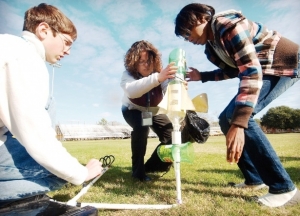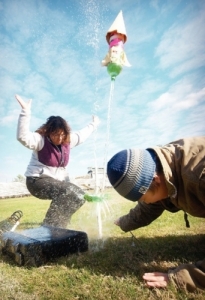Shooting for the sky
By Phyllis Moore
Published in News on December 9, 2010 1:46 PM

News-Argus/MICHAEL K. DAKOTA
Wayne School of Engineering ninth-grader Alex Domingue, left, turns on the air pressure as Jen Deschoff, center, science and engineering teacher, helps student Pascalle Adams with the launch of her bottle rocket. Students in Engineering the Future, a freshman class, built the rockets as an introduction to the world of engineering and technology.

News-Argus/MICHAEL K. DAKOTA
Jen Deschoff takes the brunt of an explosion as a water rocket explodes prematurely. Ninth-grader Kenny Stempien pulled the trigger that launches his water rocket.
Jen Deschoff, an engineering and science teacher at Wayne School of Engineering, was as excited as her students about their inquiry-based project -- launching homemade bottle rockets.
Their assignment had been to follow engineering design steps and construct a rocket, complete with such features as a nose cone and parachute.
As the ninth-grade "Engineering the Future" class assembled on the football field of Goldsboro High School at noontime Monday, Ms. Deschoff prepared to hook up a compressor to a vehicle.
She told the students they needed a water source, directing them to a hose by the school building, then explained what data to write down about their individual rocket's launch.
"Cameron (Mayo), you pace off 50 steps from the launcher," she instructed one student. Not that she envisioned the rocket would travel that far, but certainly the vantage point would allow him to gauge how high it reached.
The first launch, though, did not quite reach expectations.
In fact, water sprayed in all directions, including all over Ms. Deschoff's outfit.
"Success does not come from succeeding, it comes from failure," student Joclyen Wooten said. She said the quote was prominently displayed in their classroom.
"Nothing is a failure. We learn from our failures," Ms. Deschoff said later.
Like any good educator, the misfire might have subconsciously fit into her ultimate plan.
"The objective," she had explained earlier, was "to get them launched, have (students) look at where they failed and calculate the height that the rocket went so when they do relaunch they'll have something to compare it to."
Student Nickie Tyler was not at all discouraged by the false start.
"It was kind of like a freefall thing," she shrugged. "We tested them off of a balcony and tested to see if the wind would catch the (parachute). That's the only thing I worried about, if the wind doesn't catch it."
Kenny Stempien had had a similar concern.
"It was a lot harder because we couldn't get the parachute to come out and then couldn't make the cone stay on," he said. "We came out and practiced on the balcony and it still hasn't worked yet so we're hoping one of these works."
His group's rocket was fashioned with two liter bottles, a garbage bag "and a lot of duct tape," he explained. One problem initially, he pointed out, had been that the parachute might have been a bit too big.
Even if it didn't turn out perfectly, though, Kenny said there would be another chance to redeem themselves.
"Tomorrow we're doing trigonometry to figure out what we did wrong and then we're doing a redesign and coming out again," he said.
Joclyen Wooten and Molly Plount worked together on the experiment.
"We designed it a little bit different than the rest of the group," Joclyen said.
"We used the new soda bottles. Ours has a ridge in it," Molly said.
"And we put fins on it to see if it would go further," Joclyen added.
They also used twine instead of string because they thought it would be stronger, they said.
"If you have ever been fishing, the fishing line blows really easily with the wind and this won't blow easily," Molly said.
Teammate Cameron said they collaborated on the project for about a week, trying to get it just right.
"We built fins, we built a house for our parachute and we even designed our parachute," he said. "We cut a square (out of a garbage bag) and then cut both ends off and punched holes in each corner."
Pascalle Adams said she was pretty confident going into the assignment, as she had previously done similar experiments.
"I have done it every year since about fifth grade because I used to go to a program at East Carolina (University)," she said. "We did it differently ... but I found it to be fun because of the fact that we had to learn how to do it and it wasn't like your normal bottle rocket."
Some of the rockets launched better than others, but overall the students said they were pleased with the outcome.
"I figured that it would go higher because we had more water," said Joclyen, adding that she then took into account that some of the water would evaporate. "I'm very, very happy."
